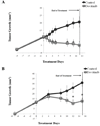Evaluation of tyrosine receptor kinases in the interactions of head and neck squamous cell carcinoma cells and fibroblasts
- PMID: 22795534
- PMCID: PMC3496822
- DOI: 10.1016/j.oraloncology.2012.06.011
Evaluation of tyrosine receptor kinases in the interactions of head and neck squamous cell carcinoma cells and fibroblasts
Abstract
Objective: Despite treatment advancements, disease-free survival of head and neck squamous cell carcinoma (HNSCC) has not significantly improved. This may be a result of tumor-fibroblasts interactions providing protective pathways for oncogenic cells to resist therapy. Further understanding of these relationships in HNSCC may improve effectiveness of targeted therapies. In this article, we investigated the role of several receptor tyrosine kinases (RTKs) in the interactions between HNSCC cells and supporting cells (fibroblasts).
Materials and methods: HNSCC cell lines and human tumor samples were evaluated for FGFR1/2/3, and PDGF-beta expression levels. Cell lines (FADU, SCC1, OSC19, Cal27, SCC22A) were treated with a range of physiological concentrations of dovitinib and assessed for proliferation, cytotoxicity, and apoptosis. Mice bearing HNSCC xenografts were treated with dovitinib (20 mg/kg).
Results: Evaluation of HNSCC tumor specimens, cell lines and fibroblasts found variable expression of multiple RTKs (fibroblasts growth factor receptor, platelet derived growth factor receptor and vascular endothelial growth factor receptor) and their ligands, supporting previous theories of paracrine and autocrine signaling within the microenvironment. In a dose-dependent fashion, RTK inhibition reduced proliferation of HNSCC cell lines and fibroblast in vitro. When HNSCC cells were cocultured with fibroblasts, RTK inhibition resulted in a smaller reduction in the proliferation relative to untreated conditions. In vivo, RTK inhibition resulted in significant tumor regression and growth inhibition (p<0.05) and reduced the incidence of regional lymph node metastasis.
Conclusion: Effective treatment of HNSCC, therefore, may require inhibition of multiple RTKs in order to adequately inhibit the microenvironment's various signaling pathways.
Copyright © 2012 Elsevier Ltd. All rights reserved.
Conflict of interest statement
No potential conflicts of interest were disclosed.
Figures






Similar articles
-
Inhibition of fibroblasts reduced head and neck cancer growth by targeting fibroblast growth factor receptor.Laryngoscope. 2012 Jul;122(7):1539-44. doi: 10.1002/lary.23266. Epub 2012 Mar 27. Laryngoscope. 2012. PMID: 22460537 Free PMC article.
-
Elevated RET expression enhances EGFR activation and mediates EGFR inhibitor resistance in head and neck squamous cell carcinoma.Cancer Lett. 2016 Jul 10;377(1):1-10. doi: 10.1016/j.canlet.2016.04.023. Epub 2016 Apr 18. Cancer Lett. 2016. PMID: 27090738
-
Characterization of ten newly-derived human head and neck squamous carcinoma cell lines with special reference to c-erbB proto-oncogene expression.Anticancer Res. 2001 May-Jun;21(3B):1953-63. Anticancer Res. 2001. PMID: 11497283
-
The role of c-erbB receptors and ligands in head and neck squamous cell carcinoma.Oral Oncol. 2002 Oct;38(7):627-40. doi: 10.1016/s1368-8375(02)00029-5. Oral Oncol. 2002. PMID: 12167415 Review.
-
Molecular parameters of head and neck cancer metastasis.Crit Rev Eukaryot Gene Expr. 2011;21(2):143-53. doi: 10.1615/critreveukargeneexpr.v21.i2.40. Crit Rev Eukaryot Gene Expr. 2011. PMID: 22077153 Free PMC article. Review.
Cited by
-
Association Between Fibroblast Growth Factor Receptor 1 Gene Amplification and Human Papillomavirus Prevalence in Tonsillar Squamous Cell Carcinoma With Clinicopathologic Analysis.J Histochem Cytochem. 2018 Jul;66(7):511-522. doi: 10.1369/0022155418761652. Epub 2018 Mar 19. J Histochem Cytochem. 2018. PMID: 29553868 Free PMC article.
-
Steroid Receptor Coactivator-3 (SRC-3/AIB1) as a Novel Therapeutic Target in Triple Negative Breast Cancer and Its Inhibition with a Phospho-Bufalin Prodrug.PLoS One. 2015 Oct 2;10(10):e0140011. doi: 10.1371/journal.pone.0140011. eCollection 2015. PLoS One. 2015. PMID: 26431029 Free PMC article.
-
Activation of Akt at T308 and S473 in alcohol, tobacco and HPV-induced HNSCC: is there evidence to support a prognostic or diagnostic role?Exp Hematol Oncol. 2014 Oct 17;3(1):25. doi: 10.1186/2162-3619-3-25. eCollection 2014. Exp Hematol Oncol. 2014. PMID: 25352995 Free PMC article.
-
Separation of cell survival, growth, migration, and mesenchymal transdifferentiation effects of fibroblast secretome on tumor cells of head and neck squamous cell carcinoma.Tumour Biol. 2017 Nov;39(11):1010428317705507. doi: 10.1177/1010428317705507. Tumour Biol. 2017. PMID: 29157176 Free PMC article.
-
Bone marrow mesenchymal stem cells increase motility of prostate cancer cells via production of stromal cell-derived factor-1α.J Cell Mol Med. 2013 Feb;17(2):287-92. doi: 10.1111/jcmm.12010. Epub 2013 Jan 10. J Cell Mol Med. 2013. PMID: 23301946 Free PMC article.
References
-
- Blume-Jensen P, Hunter T. Oncogenic kinase signalling. Nature. 2001;411(6835):355–365. - PubMed
-
- Lee SH, Lopes de Menezes D, Vora J, Harris A, Ye H, Nordahl L, et al. In vivo target modulation and biological activity of CHIR-258, a multitargeted growth factor receptor kinase inhibitor, in colon cancer models. Clin Cancer Res. 2005;11(10):3633–3641. - PubMed
-
- Freier K, Schwaenen C, Sticht C, Flechtenmacher C, Muhling J, Hofele C, et al. Recurrent FGFR1 amplification and high FGFR1 protein expression in oral squamous cell carcinoma (OSCC) Oral Oncol. 2007;43(1):60–66. - PubMed
Publication types
MeSH terms
Substances
Grants and funding
LinkOut - more resources
Full Text Sources
Medical
Miscellaneous

